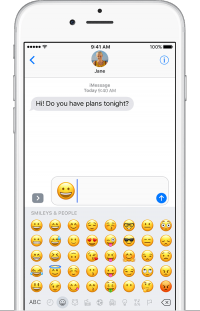Difference between revisions of "Emoji"
| Line 1: | Line 1: | ||
[[File:Iphone.png|200px|thumbnail|right|Emojis are commonly used in text messaging]] | [[File:Iphone.png|200px|thumbnail|right|Emojis are commonly used in text messaging]] | ||
| − | '''Emojis''' are small pictographic images used to represent emotions, symbols, and objects in electronic communication. These characters convey meaning, tone, and creative expression in textual | + | '''Emojis''' are small pictographic images used to represent emotions, symbols, and objects in electronic communication. With over 1,400 unique emojis<ref>http://emojipedia.org/stats/</ref> spanning categories including smileys, animals, food, nature, activity, and symbols, about 6 billion emojis are used everyday <ref>http://www.cbc.ca/news/technology/emojis-online-communication-1.3500734</ref>. These characters convey meaning, tone, and creative expression that is often absent in textual conversation. Originating from Japan, the word emoji stems from the Japanese words “e” (“picture”) and “moji” (“character”). Emojis were first introduced on Japanese mobile devices close to 2000. As Unicode characters, emojis have been able to disperse rapidly and easily into many different interfaces all across the world. Though, as emojis are increasingly being integrated into many different aspects of digital culture, they give rise to ethical concerns surrounding literacy and miscommunication. |
== History == | == History == | ||
Revision as of 18:54, 18 February 2017
Emojis are small pictographic images used to represent emotions, symbols, and objects in electronic communication. With over 1,400 unique emojis[1] spanning categories including smileys, animals, food, nature, activity, and symbols, about 6 billion emojis are used everyday [2]. These characters convey meaning, tone, and creative expression that is often absent in textual conversation. Originating from Japan, the word emoji stems from the Japanese words “e” (“picture”) and “moji” (“character”). Emojis were first introduced on Japanese mobile devices close to 2000. As Unicode characters, emojis have been able to disperse rapidly and easily into many different interfaces all across the world. Though, as emojis are increasingly being integrated into many different aspects of digital culture, they give rise to ethical concerns surrounding literacy and miscommunication.
History
Emojis were first created by Japanese telecom companies in the early 1990s, during which pagers were a popular form of communication and expression amongst teenagers. NTT Domco was looking for a way to set itself apart from competitors to capitalize in this market. Therefore, inspired by the heart image that NTT Domco already offered in their messaging service, Shigetaka Kurita invented the emoji to offer other visualizations of emotions for use in digital communication[3].
Soon after, many other Japanese mobile companies began to offer similar emojis. However, because these characters were preloaded onto mobile phones, they wouldn’t load when sent to other carriers. Therefore, in 2005, the Unicode Consortium came together to encode a standard unicode set of emojis that could be used across carriers [4]. Once adopted by Apple’s iOS5 in 2011, many others including Android, Microsoft, Google, Facebook and Twitter followed suit and have integrated emojis into their program.
